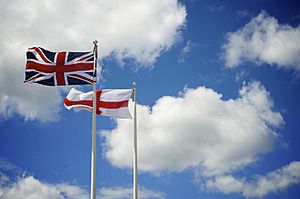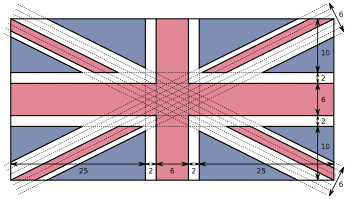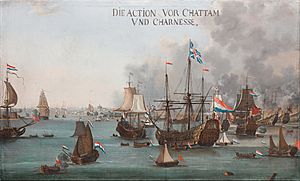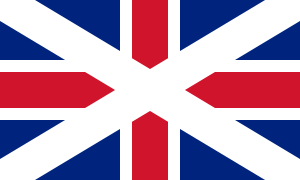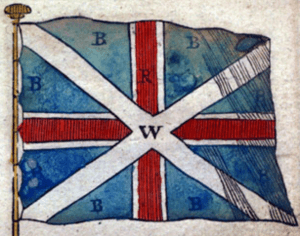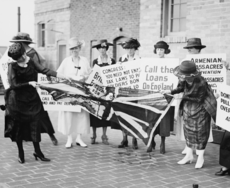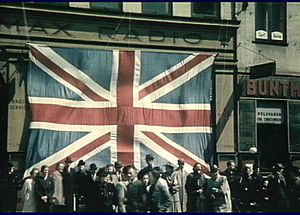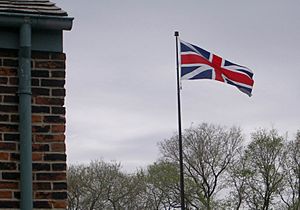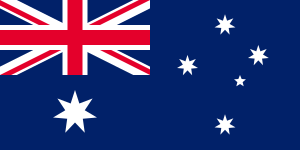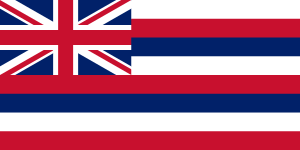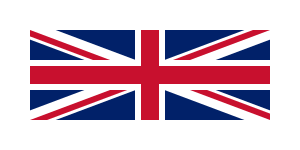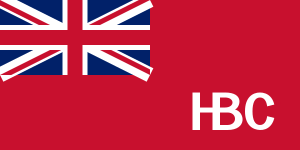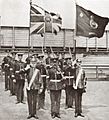Union Jack facts for kids
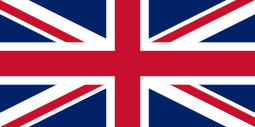 |
|
| Name | Union Jack or Union Flag Royal Union Flag (in Canada) |
|---|---|
| Use | National flag |
| Proportion | 1:2 |
| Adopted | 1801 |
| Design | Blue field on which the Cross of Saint Andrew counterchanged with the Cross of Saint Patrick, over all the Cross of Saint George fimbriated. |
The Union Jack, also known as the Union Flag, is the main national flag of the United Kingdom. Even though there isn't a specific law making it the official flag, everyone uses it as such. Some people used to say that "Union Jack" should only be used when the flag is on a ship. However, experts from the Flag Institute looked into history and said in 2013 that both names are perfectly fine to use.
In Canada, the flag is officially known as the Royal Union Flag. It is also the national flag for all British overseas territories. These are places that are part of the British state. Most of these territories also have their own local flags. These local flags usually have the Union Flag in the top corner near the flagpole.
The first version of the flag, called the flag of Great Britain, started in 1606. This was after King James VI of Scotland also became King of England and Ireland in 1603. This event joined the crowns of England, Scotland, and Ireland under one ruler. On 12 April 1606, a new flag was created for ships. It combined the flag of England (a red cross on white, called St George's Cross) with the flag of Scotland (a white X-shaped cross on blue, called saltire or St Andrew's Cross).
The flag we see today was created in 1801. This happened when Great Britain and Ireland joined together. The current flag mixes parts of three older flags:
- The red cross of Saint George for England.
- The white X-shaped cross of St Andrew for Scotland.
- The red X-shaped cross of St Patrick for Ireland.
Even though the Republic of Ireland is no longer part of the UK, Northern Ireland is.
There are no symbols for Wales on the flag. This is because Wales was already part of England when the first Union Flag was made in 1606. At that time, the idea of national flags was still quite new. However, the Welsh Dragon was added to the royal arms of England by the Tudor dynasty in 1485.
Contents
Understanding the Flag's Names
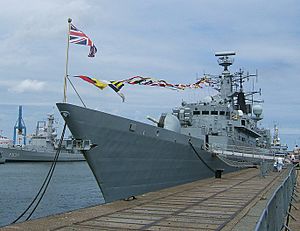
Both "Union Jack" and "Union Flag" are correct names for the UK's national flag. There used to be a debate about whether "Union Jack" should only be used when the flag is flown on a ship.
The Parliament of the United Kingdom explains that England and Scotland were separate kingdoms until 1603. That year, Elizabeth I of England died without children. The English crown then went to her cousin, James VI, King of Scotland. This meant both countries shared the same king.
In 1606, King James ordered a new British flag. It combined the crosses of St. George and St. Andrew. This flag became known as the Union Jack. The "Jack" part might come from "Jacobus," which is the Latin name for James.
The Flag Institute, a group that studies flags, says that the national flag of the UK is the Union Flag, but it can also be called the Union Jack. They note that the idea of only calling it "Union Jack" on warships is quite new. The British Navy itself often called it the Union Jack, no matter how it was used. In 1902, the Navy said both names could be used officially. In 1908, a government minister said the "Union Jack should be regarded as the National flag."
Old documents also show both names. For example, King Charles I's order in 1634 called it the "Union Flag." King George III's order in 1801 also used "Union Flag." However, when the flag was first introduced in 1606, it was simply called the "British flag." The word "jack" was used for small flags flown at the front of ships. By 1674, it was commonly called the "Union Jack."
The large size and power of the Royal Navy might also explain the name "Union Jack." Since the flag was so widely used on British ships, the term "jack" might have stuck because it was flown from the "jack staff" at the front of the ship. The name "Union Jack" has been used for centuries and is now officially accepted as the national flag.
Even famous leaders like Winston Churchill called it the Union Jack. In 1899, Churchill wrote to his mother about her new magazine. He joked that it would only need "the Union Jack & the Star Spangled Banner crossed on the cover" to look like a cheap imperialist magazine.
How the Flag Looks
The current design of the Union Flag has been used since 1801. King George III described its design on 1 January 1801.
Flag Shape and Size
The Union Jack is usually twice as long as it is tall (a 1:2 ratio). For flags flown on land in the UK, the usual ratio is 3:5. The Union Jack can also be made in this 3:5 shape, but 1:2 is more common for most uses.
Flags that have the Union Jack in their top corner should always be 1:2. This keeps the Union Jack part looking correct.
The three crosses that make up the Union Flag have specific sizes:
- The red St George's Cross is 1/5 of the flag's height wide. It has a thin white border (called a fimbriation) that is 1/15 of the flag's height.
- The white diagonal St Andrew's Cross is 6/30 of the flag's height wide. It appears on both sides of the St Patrick's Cross.
- The red diagonal St Patrick's Cross is 1/15 of the flag's height wide. It is slightly offset. The white and red diagonal crosses are "counterchanged," meaning they swap places in different parts of the flag.
The thickness of the crosses and their borders stays the same relative to the flag's height, whether the flag is 3:5 or 1:2.
Flag Colours
The Union Jack uses specific shades of blue, red, and white. These colours have different codes for different uses, like for printing or on screens.
| Scheme | Blue | Red | White |
|---|---|---|---|
| Pantone (paper) | 280 C | 186 C | Safe |
| Web-safe hex | #003399 | #CC0000 | #FFFFFF |
| MoD | 8711D | 8711 | 8711J |
| NSN | 8305.99.130.4580 | 8305.99.130.4584 | 8305.99.130.4585 |
| CMYK | 100.72.0.18.5 | 0.91.76.6 | 0.0.0.0 |
| RGB (hex) | 0, 39, 118 (#002776) | 198, 12, 48 (#C60C30) | 255, 255, 255 (#FFFFFF) |
Flying the Flag Correctly
The Union Flag is not exactly the same if you flip it upside down. This is because the red and white diagonal crosses are slightly offset. So, there is a right way to fly it.
When you look at the flag, the side that attaches to the flagpole is called the "hoist." To fly the flag correctly, the wider white stripe of St Andrew's Cross should be above the red stripe of St Patrick's Cross in the top corner nearest the flagpole. A simple way to remember this is "wide white top" or "broad side up."
Flying a flag upside down can be a sign of distress or even an insult. For the Union Flag, the difference is small and easy to miss. Sometimes, it's flown upside down by accident. For example, in 2009, the BBC reported that the UK government accidentally flew the flag upside down during a meeting with the Chinese premier.
History of the Union Flag
In 1603, James VI of Scotland became King of England and Ireland. This joined the crowns of the three countries, even though they remained separate states. On 12 April 1606, a new flag was created to show this union between England and Scotland. It combined the red cross of St George (England) and the white X-shaped cross of St Andrew (Scotland). This was the first Union Flag.
By the King: Whereas, some differences hath arisen between Our subjects of South and North Britaine travelling by Seas, about the bearing of their Flagges: For the avoiding of all contentions hereafter. We have, with the advice of our Council, ordered: That from henceforth all our Subjects of this Isle and Kingdome of Great Britaine, and all our members thereof, shall beare in their main-toppe the Red Crosse, commonly called St George's Crosse, and the White Crosse, commonly called St Andrew’s Crosse, joyned together according to the forme made by our heralds, and sent by Us to our Admerall to be published to our Subjects: and in their fore-toppe our Subjects of South Britaine shall weare the Red Crosse onely as they were wont, and our Subjects of North Britaine in their fore-toppe the White Crosse onely as they were accustomed.
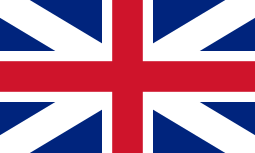 |
|
| Name | The King's Colours or Great Union Flag |
|---|---|
| Use | National flag |
| Proportion | 3:5 |
| Adopted | 1606–1707 (ships at sea) 1707–1801 (England and Scotland) |
| Design | The Cross of St George over the Cross of St Andrew |
At first, this flag was only for ships. Land forces still used their own national flags. In 1634, King Charles I said only royal ships could use it. After the Acts of Union 1707, when England and Scotland formally united to form the Kingdom of Great Britain, the flag became official for the new state. It was then used by land forces too. The blue background used on land flags was a darker shade, similar to the Scottish flag.
The blue colour of the Union Flag has changed over the years. The current flag uses a deep "navy" blue. This colour comes from the Blue Ensign used by the Royal Navy. Darker colours were chosen for flags on ships because they lasted longer.
A thin white stripe separates the red cross from the blue background. This follows a rule in heraldry (the study of coats of arms and flags) that colours like red and blue must be separated by "metals" like white or silver.
Wales was not directly represented in the Union Jack. This is because it had been part of the Kingdom of England since 1282. The Kingdom of Ireland was also not represented in the first Union Jack. However, a flag used from 1658 to 1660 did include the Irish arms.
The original Union Jack (before 1801) can still be seen today. For example, it is in the top corner of the Commissioners' Ensign of the Northern Lighthouse Board. This is the only official use of the pre-1801 flag in the UK today. This older flag also appeared in the first widely used flag of the United States, called the Grand Union Flag.
Scottish Union Flag
When the 1606 Union Flag was designed, the cross of St George was placed on top of the cross of St Andrew. Some Scots were unhappy about this. They felt their cross should be on top. They complained to King James VI. Although their suggested designs are lost, there is evidence of an unofficial Scottish version of the flag where the Scottish cross was on top. It seems this flag was used unofficially on Scottish ships in the 17th century.

On land, an engraving of Edinburgh Castle from around 1693 shows the Scottish version of the Union Flag flying.
In 1707, just before England and Scotland officially united, Queen Anne and her advisors looked at several flag designs. One design showed the Scottish cross on top. However, the Queen chose the original design with the English cross on top.
The Flag Since 1801

The current Union Flag dates from 1 January 1801. This was when the Act of Union 1800 joined the Kingdom of Ireland with Kingdom of Great Britain to form the United Kingdom of Great Britain and Ireland. The new design added a red X-shaped cross, the cross of Saint Patrick, for Ireland. This cross is woven with the St Andrew's cross so that the white always appears clockwise after the red. This design means the flag must be flown "the right way up." Like the red cross, the red X-shaped cross also has a white border.
The cross of St Patrick has not been widely used to represent Ireland on its own. It is thought to come from the powerful FitzGerald family's coat of arms, not directly from the saint.
What if Ireland Left?
When the Anglo-Irish Treaty was signed in 1921, leading to the creation of the Irish Free State, people wondered if the cross of St Patrick would be removed from the Union Jack. Newspapers reported that changes were being considered. However, because Northern Ireland chose to remain part of the United Kingdom, the cross of St Patrick stayed in the flag. The Prime Minister of Northern Ireland, Sir James Craig, said in 1921 that he was "glad to think that our decision [to stay in the United Kingdom] will avoid the need to damage the Union Jack." The flag has not been changed since then.
Ideas for a New Union Flag
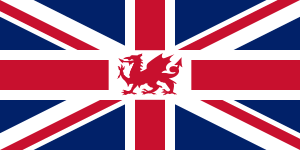
In 2003, there was a campaign to add black stripes to the Union Flag to represent different races. This idea was not popular and was criticized as "ridiculous." The campaign no longer exists.
Since there is no symbol for Wales in the Union Jack, some people have suggested adding the Welsh Dragon to the flag. In 2007, a Member of Parliament for Wrexham, Ian Lucas, suggested this in the House of Commons. He said the Union Jack only represents England, Scotland, and Ireland. The Minister for Culture, Margaret Hodge, agreed it was a good point for discussion. This led to design contests, with many ideas for how to include Wales. The reason Wales isn't on the flag is that it was already part of England when the first Union Flag was created in 1606.
Before the 2014 Scottish independence referendum, some unofficial ideas for a new flag without the St Andrew's Cross were suggested, in case Scotland became independent. However, Scotland voted to stay in the UK, so this issue did not arise.
Brexit and the Flag
After the UK voted to leave the European Union in 2016 (known as Brexit), the Union Flag became a symbol of wanting to leave the EU in some places. For example, in Italy, businesses flew the flag to protest against new rules.
How the Flag is Used

The Union Jack is used as a "jack" flag by warships and submarines of the Royal Navy. It is flown from a small flagpole at the front of the ship when it is anchored. When a ship is moving, the Union Jack is only flown for special events, like the King's official birthday.
The Union Jack is also flown at the top of a ship's mast if the King or a very senior admiral is on board. It can also be flown from the side of a ship to show that a court-martial (a military court case) is happening.
There is no law that officially made the Union Jack the national flag of the UK. It became the national flag over time through common use. In 1908, Parliament stated that "the Union Jack should be regarded as the National flag." In 1933, the Home Secretary said that "the Union Flag is the national flag and may properly be flown by any British subject on land."
Anyone can fly the Union Flag on land. However, flying the flag at sea is usually restricted to military ships. In the 17th century, some ships used the flag illegally to avoid paying port fees. Because of this, King Charles I ordered that only royal ships could use the flag. It is still against the law for most British merchant ships to fly the Union Flag. Instead, naval ships fly the White ensign, merchant ships fly the Red Ensign, and some special groups like naval yacht clubs fly the Blue Ensign. All these ensigns have the Union Flag as part of their design.
The Court of the Lord Lyon King of Arms, which deals with flag rules in Scotland, says that the Union Jack is the correct flag for all UK citizens and groups to fly to show their loyalty and nationality.
In Australia and New Zealand, the Union Flag was gradually replaced by their own national flags. However, the laws in both countries still allow people to fly the Union Jack.
In 2008, a Member of Parliament, Andrew Rosindell, tried to pass a law to make the Union Flag officially the national flag and to confirm that "Union Jack" is an equally correct name. However, this bill did not become law.
Canada's Royal Union Flag
The Union Flag's older version was used in what is now Canada as early as 1621. It was also the official flag of Newfoundland.
In 1964, when Canada chose its new Maple Leaf Flag, the Canadian Parliament decided to call the Union Flag the Royal Union Flag. They said it would be a symbol of Canada's connection to the Commonwealth and the King or Queen. A rule says the Royal Union Flag should be flown alongside the Maple Leaf Flag at federal buildings and military bases on three special days each year: Commonwealth Day, the King's official birthday, and the anniversary of the Statute of Westminster 1931. This is only done if there is more than one flagpole, so the Canadian flag is not removed.
Other Flag Ratios
Proportions: 3:5 |
While the 1:2 ratio is most common, the Union Flag can also be 3:5. The 3:5 version is often used by the British Army and is sometimes called the War flag.
Used in Other Flags
Other Countries and Regions
The Union Flag is found in the top-left corner of the flags of many former British colonies. The background colour of these flags often matched the colour of the British naval squadron that patrolled that area. As these countries became independent, many changed their flags. The most recent change was on 1 July 1997, when Hong Kong was returned to China.
All British regions and territories, except Gibraltar and the Crown dependencies, fly the Union Jack in some way. Outside the UK, it is usually part of a special flag.
Four former British colonies in Oceania still have the Union Jack in their national flags: Australia, New Zealand, and Tuvalu (which still have the King as head of state), and Fiji (which became a republic).
In Canada, the Union Jack was used a lot until the Maple Leaf Flag was introduced in 1965. However, it is still used in the flags of some Canadian provinces, like British Columbia, Manitoba, and Ontario. Newfoundland and Labrador uses a changed version of the Union Flag.
Many other Australian flags also use the Union Jack, including the flags of the Royal Australian Navy and Air Force, and the flags of all six Australian States.
The flag of the Basque Country, called the Ikurriña, is also similar to the Union Jack. This shows the strong trade links between Bilbao and Britain in the past.
The Union Jack was part of the first flag of the United States, the Grand Union Flag. The state of Hawaii, located in the Pacific, still has the Union Jack in its state flag. One story says that the King of Hawaii asked a British sailor what the flag on his ship meant. The sailor said it showed his king's power. The Hawaiian king then adopted the flag as a symbol of his own royal power. Hawaii's flag is the only US state flag that uses the Union Jack.
The Union Flag of 1606 is also in the flag of Baton Rouge, the capital city of Louisiana. Baton Rouge was a British colony for a time.
The Union Jack also appeared on the flags of South Africa from 1910 to 1994.
The coat of arms of the Chilean city of Coquimbo also features the Union Jack because of its historical trade connections with Britain.
-
The flag of Tuvalu
-
The flag of Fiji
-
The Queensland State flag
-
The flag of the Province of Ontario, Canada
-
The flag of the Canadian Province of Manitoba
-
The flag of the Canadian Province of Newfoundland and Labrador
-
The flag of Bermuda
-
Falkland Islands Flag
-
Flag of Taunton, Massachusetts
-
Flag of the United States (1775–1777) later named the Grand Union Flag
-
1957 version of the Canadian Red Ensign national flag until 1965
-
The flag of Rhodesia between 1964 and 1968
-
Oranje-blanje-blou, or the Flag of South Africa (1928–1994)
Ensigns
The Union Flag is found in the top corner of several special flags called "ensigns." These ensigns are flown by ships and aircraft of the UK and its overseas territories. They are used when it's not allowed to fly the Union Flag alone, like on a merchant ship at sea. British naval ships fly the White ensign, merchant ships fly the Red Ensign, and government ships fly the Blue Ensign. All these ensigns include the Union Flag in their design. Other Commonwealth countries also use similar ensigns, but with their own national flag instead of the Union Flag.
-
Royal Navy White Ensign.
-
Royal Air Force Ensign.
-
Isle of Man Red Ensign
-
Cayman Islands Red Ensign.
-
Royal Australian Navy Ensign.
-
Royal New Zealand Navy Ensign.
-
Fiji Naval Ensign.
Pilot or Civil Jack
A version of the Union Jack with a white border is sometimes seen on merchant ships. This was once called the Pilot Jack because it was used as a signal flag for a pilot (someone who guides ships into harbours). While it's no longer the official signal for a pilot, it is still legally allowed to be flown on merchant ships. Many civilian ships continue to fly this white-bordered Union Flag.
Other Uses
The Hudson's Bay Company (HBC), a very old trading company, used the Union Jack as part of its flag. This flag is no longer used.
The Union Jack is also part of the 1939 coat of arms of Alabama in the United States. This represents British rule over the state before 1783.
The coat of arms of the Chilean city of Coquimbo also features the Union Jack, due to its historical trade links with Britain.
Flag Days
In July 2007, the Prime Minister at the time, Gordon Brown, announced plans to fly the Union Flag more often from government buildings.
Before this, the flag was usually only flown on public buildings on special days. These included birthdays of the Royal Family, the monarch's wedding anniversary, Commonwealth Day, and Remembrance Sunday. The Union Flag is flown at half mast (halfway down the flagpole) when the King or Queen dies.
The current official flag days for government buildings in the UK are:
- 9 January (Birthday of The Duchess of Cambridge)
- 20 January (Birthday of The Countess of Wessex)
- 6 February (Anniversary of the accession of The Queen)
- 19 February (Birthday of The Duke of York)
- Second Monday in March (Commonwealth Day)
- 10 March (Birthday of The Earl of Wessex)
- 21 April (The Queen's Birthday)
- 9 May (Europe Day)
- 2 June (Anniversary of The Queen's coronation)
- 10 June (Birthday of The Duke of Edinburgh)
- June (no fixed date) – The Queen's Official Birthday
- 21 June (Birthday of The Duke of Cambridge)
- 17 July (Birthday of The Duchess of Cornwall)
- 15 August (Birthday of the The Princess Royal)
- Second Sunday in November (Remembrance Sunday)
- 14 November (Birthday of The Prince of Wales)
- 20 November (Anniversary of the wedding of The Queen and The Duke of Edinburgh)
In addition, the Union Flag should be flown in specific areas on these days:
- 1 March (Wales only, for St David's Day)
- 17 March (Northern Ireland only, for St Patrick's Day)
- 23 April (England only, for St George's Day)
- The Day of the Opening of a Session of the Houses of Parliament, Greater London only.
- The day Parliament ends a session, Greater London only.
On 30 November (Saint Andrew's Day), the Union Flag can be flown in Scotland only if a building has more than one flagpole. On this day, the Scottish flag (Saltire) will not be lowered for the Union Flag if there is only one flagpole. This rule was made after Scottish politicians complained that Scotland was the only country that couldn't fly its national flag on its national day.
Non-government groups can fly the Union Flag whenever they choose.
How to Use and Dispose of the Flag
The Union Flag doesn't have official rules about how it should be used or if it can be damaged. In Northern Ireland, there are rules for flying the flag on government buildings, including when it should be flown at half mast.
There is no specific way to fold the Union Flag, unlike the US Flag. It is usually folded neatly so it can be easily attached to the flagpole again.
Old Royal Navy rules from 1914 said that flags that were too old to be used should be torn into small pieces and thrown away as rags. The only exception was flags that had been flown in battle; these could be kept in a museum.
Other Names for the Flag
- In Hong Kong, the flag is sometimes called the Rice-Character Flag (米字旗) in Chinese. This is because its pattern looks like the Chinese character for "rice" (米).
- The Butcher's Apron is a negative term for the flag, mostly used by Irish republicans. This name refers to the flag's red stripes looking like blood and is linked to past conflicts.
In Popular Culture
The Union Jack is a symbol of British pride and identity. It can also be linked to military history.
Winston Churchill wrote about the Union Jack as a symbol of British nationalism and empire. In 1899, he joked that a magazine cover with the Union Jack and the American flag would look like a cheap imperialist publication.
The Union Flag has been a popular symbol in fashion since the 1960s. It's often seen on clothing, especially after events like the 2012 London Olympics. Many music artists, from rock bands like The Who and Iron Maiden to pop groups like the Spice Girls, have used the Union Flag as part of their image.
The Union Flag is also commonly used as an icon on websites and software to show a choice of the English language.
Images for kids
-
Colour party of the 9th Battalion, Durham Light Infantry with new colours presented by Edward VII on 19 June 1909
-
King's Colour, of 2nd Battalion, 17th Dogra Regiment, British Indian Army (National Army Museum)
-
The Union Jack at half-mast following the death of Prince Philip, Duke of Edinburgh.
-
An Australia Day parade in Pittsworth, with the lead marcher carrying a Union Flag, 1915.
-
The Union Flag has official status in Canada and is shown next to the flag of Canada during a Remembrance Day parade in Stirling, Ontario (2009).
-
Map of the British Empire (as of 1910)
-
Geri Halliwell of the Spice Girls wearing a remake of the Union Jack dress she wore at the 1997 Brit Awards
-
Orangemen parading in Belfast, Northern Ireland
-
British Airways fleets bearing Chatham Dockyard Union Flag tail art at London Heathrow Airport
-
White Ensign of the Royal Hamilton Amateur Dinghy Club of Bermuda.


